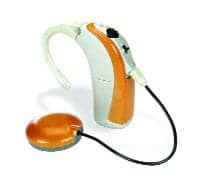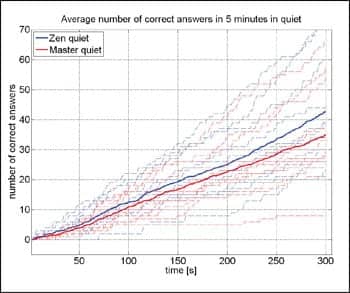| This article was submitted to HR by Francis Kuk, PhD, director of audiology, and Heidi Peeters, MA, research audiologist, at the Widex Office of Research in Clinical Amplification (ORCA), Lisle, Ill. Correspondence can be addressed to [email protected] or Francis Kuk at . |
One of the negative consequences with a higher standard of living in modern societies is the increased level of stress that their citizens’ experience. According to the American Institute of Stress, the number one health problem in the United States is stress.1 Many of the chronic health issues such as insomnia, heart diseases, etc, can be partially attributed to the increased stress of modern living. The incidence of increased stress is reportedly higher in people with a hearing loss than the normal-hearing population.2 In addition, the instance of stress in those with an untreated hearing loss is reportedly higher than in those with a treated hearing loss (12-17% versus 7-12%), according to the US National Council on Aging (NCOA).3
One of the reasons for increased stress in individuals with hearing loss is likely related to the increased incidence of communication failures experienced by these people. This obviously highlights the importance of amplification and the quality of life improvement reported by many hearing-impaired people with the use of hearing aids.4,5
Improving the consistency of communication success (through amplification) narrows the discrepancy in stress levels experienced by normal-hearing and hearing-impaired people. However, there is no reason why hearing-impaired people and normal-hearing people alike would not want to further improve their quality of life with a lower daily stress level. A survey conducted by The New York Times in 2000 showed that 64% of the general population listened to music to relax and 8% participated in meditation or yoga classes for relaxation. The latter percentage is likely higher these days especially with the Boomer population who are more conscious about their health and are more willing to work toward maintaining a higher quality of life. This is evident in the increased number of relaxation and meditation programs offered online and at community fitness centers.

|
| FIGURE 1. Diagram of the various areas of the brain that are involved in music processing. The areas involved in music processing and emotional responses are indicated. |
Given the trend toward an increased emphasis on (and need for) relaxation by the general population and the potential usefulness of music to induce a relaxation effect, it is incumbent upon the hearing care profession to understand how music may have such an effect on the overall well-being of people. This is so that we, as a profession, may do our best to ensure the consistent and convenient use of music by people with a hearing loss—not only for its entertainment value, but also for its therapeutic benefits.
This article provides a brief introduction to the neurological representation of music and its physiological effect. This is followed by a summary of the characteristics of music that are known to be most conducive to relaxation and how these characteristics can be integrated into the design of a digital signal processing hearing aid so that music can be conveniently and discreetly used by hearing aid wearers. The results of a preliminary study on the efficacy of such an algorithm will be reported.
Neurological Representation of Music
The processing of timing features of music begins as early as the cochlear nucleus within the brainstem.6 Processing of music is conducted in the Heschl’s gyrus of the auditory cortex and the limbic system (Figure 1). Heschl’s gyrus has been found to be larger in musicians compared to non-musicians. It also produces greater magnetoencephalographic (MEG) activity when patients are presented with a musical stimulus.7
In addition, music is processed in both hemispheres of the brain within the primary and secondary auditory cortices. While the right hemisphere has been shown to be responsible for the processing of timbre, pitch, and melody, the left hemisphere has been shown to process rhythmic information.7,8 As the musical signal enters the primary auditory cortex, it is further analyzed in other areas of the brain, including the planum temporale, perisylvian language centers, motor areas, and the frontal lobe.
The limbic system is associated with emotions and is highly involved in music processing. Parts of the limbic system that have shown activities to music stimulation include the amygdala, hypothalamus, prefrontal cortex, and the ventral tegmental area.7 It has been seen in animal studies that exposure to slow instrumental music alters the levels of certain neurotrophins in the hypothalamus. These changes in the concentration of neurotrophins could also lead to a reduced stress response, which is regulated by the hypothalamus.9

|
| FIGURE 2. The relationship proposed by Sluckin et al24 relating liking (favorability) and familiarity of a stimulus. |
The location within the limbic system where the signal is processed may be associated with a particular emotion elicited by the musical piece. For example, a change in the key (mode) of the music often influences the emotional reaction. Music played in a major key (often eliciting pleasant emotions) has been shown to activate the orbitofrontal area of the brain in the right hemisphere, as well as an area below the corpus callosum. Music played in a minor key (associated with more unpleasant emotions) has been shown to activate the right parahippocampal gyrus.8
Furthermore, perception of happy and sad music, which is categorized as such without specifically considering the key of the music, has been shown to activate areas of the brain comparable to those distinguished above for major/minor keys. Happy musical pieces have been associated with activation of specific portions of the limbic system including the ventral striatum (bilaterally) and left hemispheric structures, including the dorsal striatum, parahippocampal gyrus, and the anterior cingulate cortex. Sad musical pieces activate the right medial temporal structures, including the hippocampus and amygdala.10
Physiological Effect of Music
Changes in a person’s mood and emotions while listening to music have been linked to physiological changes in heart rate and respiration rate. This may be mediated by changes in the release of arousal hormones, including epinephrine (adrenaline) and cortisol from the adrenal glands.11 The musical characteristics that may be responsible for influencing changes in heart rate of listeners included changes in tempo and aesthetics, intensity, rhythm, and texture (having to do with the number of voices or instruments) of music.12 Specifically, researchers found that subjects’ heart rates and respiration rates decreased over time when listening to a sedative piece of music. However, heart rates remained the same and respiration rate increased over time in response to an excitative piece of music.
In addition to heart rate and respiration rate, music can also cause changes in blood pressure, muscle tension, skin conductance, tears, chills, the release of hormones, and skin temperature.13-17
Relaxation and Music

|
| FIGURE 3. Block diagram showing similarity between music production and Zen tone production using fractals. |
Not all music produces the same physiological and emotional effects. For example, Kamenetsky et al18 reported that musical pieces with steady rhythms are perceived as sacred or serious, while choppy rhythms are perceived as happy and playful. Staccato (presentation of short quick notes) pieces are perceived as lively and energetic, while legato (style with smooth transitions between notes) music is generally interpreted as gentle and peaceful. Loud music is perceived as being happy, energetic, or active, while soft music is perceived as peaceful and delicate. Generally fast tempos are perceived as happier than slow tempos, and major key modes are also perceived as happier than minor keys.18-19 Obviously, not all musical pieces that follow these suggestions will result in a happy emotion; past experience of the listeners could also affect the emotions/mood of the specific musical piece.
Music selected for the purpose of relaxation shares some common characteristics.20,21 These include providing a tempo at or below resting heart rate (60 to 72 beats per minute [bpm]), predictable dynamics (soft to moderately loud), fluid melodic movement, pleasing harmonies, regular rhythm without sudden changes, and tonal qualities that include flute, strings, or piano. Sounds of the voice, organ, and acoustical wind instruments are also recommended. In addition, Robb et al20 suggested including a greater number of lower pitches to promote relaxation.
Wolfe et al22 evaluated music parameters that promote and disrupt relaxation. The parameters that promote relaxation include few changes in tempo, volume, or instrumentation. Bass sounds, slow tempos, and small numbers of instruments promote a relaxing quality. Those features reported as disruptive to relaxation included depressing music, loud volume, and high-pitched instruments. While listeners can provide descriptors of the musical characteristics that contribute to relaxation, the integration of these features to create a pleasing piece of music is a complex process.
Using Commercial Music for Relaxation
It is clear from the previous discussion that not all commercial music is intended for (nor should it solely serve) a relaxation purpose. In addition, what is relaxing for one listener may not be relaxing for another, even though the music includes many relaxing characteristics. Despite such a difficulty, there is an increasing number of CDs and sound effects tapes that are marketed for relaxation purposes only. Typically, they can be played back on devices, such as CD players, MP3 players, cell phones, or computers, via external loudspeakers or headphones.

|
| TABLE 1. Acoustic characteristics of the four Zen styles available in the MIND440. |
While this method of delivery is the generally accepted way of delivering relaxing or calming music, it could be inconvenient for hearing aid wearers. They may only be able to listen to the music in the soundfield (thus limiting when and where the music can be listened to), with headphones (from MP3 players and/or cell phones) without the hearing aids (thus limiting audibility and sound quality), or with their hearing aids via direct audio input (DAI) option (limited to BTEs). There is also another consideration that may not be obvious—keeping the novelty (or effectiveness) of the music.
One of the challenges in applying music for relaxation is to make the music aesthetically pleasing (and relaxing) to the listener for as long as it is required. Unfortunately, the same piece of music could lose its novelty and effectiveness after repeated listening. Indeed, music presented over time creates expectations of what is to come and this influences the listener’s emotional reactions to the music. Positive emotions are elicited when these expectations are met during music listening.23 In addition, Sluckin et al24 also noted that the opinion of a novel stimulus (such as a new piece of music) is negative rather than neutral given that humans are generally resistant to change. Therefore, the relationship between liking a music stimulus and its familiarity begins with dislike when the stimulus is introduced, followed by an increase in the liking for the stimulus as it becomes more familiar (Figure 2).
Finally, as exposure and familiarity with the stimulus increase, the liking for the stimulus decreases because of satiation. This could render the music less effective to elicit the desired effect (eg, relaxation).
Preserving the Novelty of Music Stimuli: Applications of Fractal Music
To avoid the familiarity problem of music, one may never repeat the music. This would require storage of thousands of songs in order to avoid repeating the same music. This may be possible for some but difficult for most listeners.

|
| FIGURE 4. The number of subjects who reported a particular rating for the question “Does this music provide a relaxing listening background for you?” for each Zen style, including the optimized condition. Average responses are connected by the dashed line, with 1 representing “very relaxing” and 2 representing “somewhat relaxing.” |
To overcome the dilemma of the decreasing novelty of a musical stimulus over time, one may generate music that never repeats itself completely. This can be done using fractals. The Wikipedia definition of a fractal is “rough or fragmented geometric shape that can be split into parts, each of which is (at least approximately) a reduced-size copy of the whole, a property called self-similarity. The term was coined by Benoît Mandelbrot in 1975 and was derived from the Latin fractus meaning ‘broken’ or ‘fractured.'”
For an object to qualify as a fractal, it has to satisfy three criteria. First is the criterion of self-similarity (ie, it is a reduced copy of the whole). Second, it must have fractional dimensions (eg, 1.34) instead of integer dimensions (eg, 1, 2, 3). And last, it must be recursive or self-generating. These three criteria allow fractals to explain and quantify the semi-random objects we see in nature (such as clouds, trees, coastline, etc) as well as to generate objects (arts and music) in a semi-random way.
In applying fractals to music generation, specific mathematical formulae are written to govern what notes are to be played and what rules are applied in order to create a desirable musical experience. Beauvois25 reported that the appeal of fractal music is its ability to create music that meets aesthetic preference. Furthermore, fractal music can continue forever without necessarily repeating the same sequence of notes while maintaining the desired novelty (and hopefully maintaining the emotion of the listener).
For hearing care professionals, it should be recognized that, since fractal music is generated with mathematical equations, it can be conveniently implemented in a digital signal processing (DSP) hearing aid. Thus fractals offer a practical means for hearing-impaired patients to conveniently and discreetly hear relaxing music while wearing their hearing aids. This frees the wearers from connecting the music source to the hearing aid (either through hard-wired DAI or wireless transmission such as Bluetooth) or listening to the music without the hearing aids. The integrity of the music signal is further ensured when the wearers do not have to hear music from a soundfield loudspeaker where room acoustics could modify the integrity of the signal. In addition, the wearers can listen to the music at any time and in any place discreetly without interfering with anyone.
Applying Fractals in Hearing Aids

|
| FIGURE 5. Instances in which at least one adjective was selected in a descriptor category for each of the four variations of the Zen fractal music and the individually optimized Zen music. |
This month Widex introduces the mind440 hearing aid, with a design directive to provide extra quality-of-life improvement to its wearers and dispensers who fit the device. To achieve that objective, Widex further improved hearing aid features to ensure consistently good sound quality, audibility, and intelligibility in different listening situations. The rationale is that consistent communication would reduce the frustration and stress of hearing-impaired individuals and further improve their quality of life.
Because of the prevalence of stress in the hearing-impaired population and the suggested efficacy of music in reducing overall stress, Widex included a feature in the mind440 so its wearers may listen to music for relaxation discreetly and conveniently. It is the first hearing aid that generates music using a patented fractal algorithm.
Hearing aid “hardware.” The mind440 uses the Dual Integrated Signal Processing (Dual-ISP) platform. It is a 15-channel enhanced dynamic range compression hearing aid with a compression threshold that can be as low as 0 dB HL in each of the 15 channels. TruSound compression is used to ensure that the nuances of the input signals are preserved. It has an input dynamic range of 107 dB SPL, high sampling rate of 32 KHz, and high-bit resolution of 20 to 32 bits. Furthermore, adaptive slow-acting compression is used to preserve the temporal fine structures of the input, while the five-segment input-output curve captures the naturalness of the input and allows extra specificity of the processing. Another new feature, TruSound AOC uses fast-acting broadband gain reduction and slow-acting narrow band gain reduction to handle loud output of the hearing aid. An optional music program (not the fractal music) is available that further optimizes the frequency gain response, directionality, and noise reduction for music listening. These features ensure that music reception is optimized.
Hearing aid “music software.” Another optional listening program is the Zen. This program generates music based on a patented fractal algorithm. There are three steps in music generation. First, a “random” number sequence is generated by the fractal generator. These numbers are assigned their pitch, tempo, and intensity based on pre-defined rules. Finally, as many as 12 music generators decode these “numbers” and generate the desired music. The spectrum and level of these tones compensate for the in situ hearing loss of the wearers. After its generation, one has the option to mix these tones with the amplified external sounds. A block diagram showing the similarity between “music production” and “fractal music production” is shown in Figure 3.

|
| FIGURE 6. Average number of targets (darker lines) eliminated during 5 minutes on the concentration grid test for the master (red) and Zen programs (blue). The dashed lines are the results of individual subjects. |
The music is composed of tonal notes with an overall chime or bell choir quality. These tones are generated based on pre-defined rules that Widex engineers developed based on an understanding of the optimal music characteristics for relaxation. The use of fractals results in tones that do not repeat themselves. This assures the novelty of the generated sounds and allows for aesthetically pleasing sounds.
There are five pre-defined Zen styles or patterns—each with a unique combination of tonal pitch, tempo, and intensity based on the in situ hearing loss of the wearers. However, each style can be further adjusted on its volume, pitch, and tempo to produce the most desirable (or relaxing) sound for the wearer. Because of the use of Dual-ISP, the level of the Zen tones also adjusts automatically to be above the level of the ambient noise in the environment. Zen music may be played in addition to conventional amplification or it may be played alone with the hearing aid microphones turned off. In addition, it may be played along with a low-level broadband noise background. These programs are accessible through a program button or a remote control.
The program is intended to provide a relaxing sound background so adult hearing aid wearers (>21 years) may use it for relaxation in quiet where listening to the environment and/or speech is not critical. It is intended as a convenient and discreet alternative music source for hearing-impaired people who use external calming music for relaxation or those who desire a music background while enjoying quiet hobbies such as reading, knitting, cooking, etc.
Clinical Study on the Efficacy of New Hearing Instrument
The efficacy of the Zen tones on relaxation and concentration was evaluated using a mind440 micro-size (M4-m) behind-the-ear (BTE) hearing aid. A total of 14 adults ranging from 61 to 87 years old (mean age of 73) with mild to moderately severe hearing loss participated in the study. Subjects were fit monaurally with an instant fit foam ear-plug in their preferred ear following standard fitting procedure (ie, sensogram and feedback test). The default gain settings of the hearing aid were used. Verification of the fitting was achieved by examining the frequency-output curve and the simulated aided thresholds to establish audibility and comfort. All testing was conducted in a 10 x 10 x 6 foot sound booth.
Subjects evaluated four Zen styles. The acoustic characteristics of these styles are described in Table 1. Each Zen style was presented for 10 to 15 seconds or until the participant was able to reach an impression. Subjects first described their emotions associated with each Zen style (see description below). They then answered a question on each Zen style: “Does this music provide a relaxing listening background for you?” using a 1 to 5 point scale with 1 being “very relaxing” and 5 being “very tensing.” Afterward, subjects adjusted the pitch and tempo of their preferred Zen style to further fine-tune the musical sound for relaxation using a paired comparison format.
Figure 4 shows the frequency of a particular rating and the average subjective rating for each Zen style on the question “Does this music provide a relaxing listening background for you?” Most subjects responded with a 1 (very relaxing) or 2 (somewhat relaxing) for all the Zen programs. Of the 14 participants, 8 rated the Zen Coral style to be very relaxing. After additional fine-tuning, 12 of the 14 subjects found the fine-tuned preferred Zen style to be relaxing. This confirms that the Zen tones have the potential to provide a relaxing listening background for the majority of hearing aid wearers.
Subjects described their emotions to each Zen style by circling all of the appropriate adjectives in a prepared list. The list included 24 words grouped into four categories: relaxing (10 words), uplifting (6 words), neutral (2 words), and negative (6 words). The number of subjects who selected at least one adjective from a given category was tallied. For example, if a subject selected “relaxing” and “calm” for a Zen style, only one instance in the category of “relaxing” would be counted (because relaxing and calm belong to the same category). This method of analysis minimized the bias from the uneven number of descriptors in each category. Note also that subjects could place a Zen style in more than one category. For example, Zen Coral could be rated as both “relaxing” and “uplifting” by a subject.

|
Figure 5 shows that all 14 subjects felt the Zen Coral was “relaxing.” In addition, the Zen Lavender style was described to be “uplifting” more frequently than it was described to be “relaxing.” This may be attributed to the faster tempo used by Lavender. It is also interesting that the individually optimized Zen was not described to be “relaxing” as often as Coral; however, it was described to be “uplifting” more often than Zen Coral.
In total, 11 participants completed an evaluation to determine if the individually optimized Zen style would assist in concentration. Subjects completed a concentration grid task26 in which they were asked to eliminate as many numbers as possible in a 5-minute period from a 10×10 block, starting with 00 and moving up sequentially to 99. The concentration grid was repeated for conditions with the hearing aid microphone only (Zen off) and the hearing aid microphone with Zen on. These conditions were repeated for quiet and broadband noise conditions (50 dB SPL).
The results for the quiet and noise backgrounds were similar; thus only the results for the quiet condition are shown in Figure 6. One observes that more numbers were identified when the Zen was active than when it was deactivated. This suggests that subjects may have been more attentive to the task when the Zen tones were “on” than when the tones were “off.” A two-way t-test showed that the performance difference between the Zen on and off conditions was statistically significant after 250 s (t = 2.96, P < 0.01).
Discussion
The study clearly demonstrated the relaxing nature of the Zen program and its potential usefulness to provide a relaxing listening background for its wearers. Thus, it could serve as a convenient and discreet alternative sound source for adult hearing aid wearers who are using or who plan to use calming/relaxing music to achieve relaxation. This may provide value-added services and further improve the quality of life of hearing aid wearers who practice relaxation.
As with the use of music for relaxation, Zen should be used only in quiet when listening to external daily sounds such as speech, traffic, etc, is not critical. Hearing care professionals should properly guide their clients in the use of this tool and set the right expectations.
References
- The American Institute of Stress. America’s No. 1 health problem, 2008. Available at: www.stress.org/americas.htm?AIS=26e06b0a6b2e327862500973b548c3c3. Accessed September 19, 2008.
- Fellinger J, Holzinger D, Gerich J, Goldberg D. Mental distress and quality of life in the hard of hearing. Acta Psychiatr Scand. 2007;115(3):243-245.
- National Council on Aging (NCOA). The consequences of untreated hearing loss in older persons, 1999. Available at: www.ncoa.org/content.cfm?sectionID=11&detail=927. Accessed September 19, 2008.
- Mulrow CD, Aguilar C, Endicott JE, et al. Quality-of-life changes and hearing impairment. A randomized trial. Ann Intern Med. 1990;113(3):188-194.
- Kochkin S, Rogin C. Quantifying the obvious: The impact of hearing instruments on quality of life. Hearing Review. 2000;7(1):6-34.
- Griffiths TD. The neural processing of complex sounds. Ann NY Acad Sci. 2001;930:133-42.
- Limb CJ. Structural and functional neural correlates of music perception. Anat Rec A Discov Mol Cell Evol Biol. 2006;288(4):435-446.
- Weinberger NM. Music and the brain. Sci Am. 2004;291(5):88-95.
- Angelucci F, Ricci E, Padua L, Sabino A, Tonali PA. Music exposure differentially alters the levels of brain-derived neurotrophic factor and nerve growth factor in the mouse hypothalamus. Neurosci Lett. 2007;429(2-3):152-155.
- Mitterschiffthaler MT, Fu CH, Dalton JA, Andrew CM, Williams SC. A functional MRI study of happy and sad affective states induced by classical music. Hum Brain Mapp. 2007;28(11):1150-1162.
- Brunges M, Avigne G. Music therapy for reducing surgical anxiety. Clin Innov. 2003;78(5):816-818.
- Iwanaga M, Ikeda M, Iwaki T. The effects of repetitive exposure to music on subjective and physiological responses. J Music Ther. 1996;33:219-230.
- Smolen D, Topp R, Singer L. The effect of self-selected music during colonoscopy on anxiety, heart rate, and blood pressure. App Nurs Res. 2002;16(2):126-136.
- Gerra G, Zaimovic A, Franchini D, et al. Neuroendocrine responses of healthy volunteers to ‘techno-music’: relationships with personality traits and emotional state. Int J Psychophysiol. 1998;28:99-111.
- Grewe O, Nagel F, Kopiez R, Altenmüller E. Listening to music as a re-creative process: physiological, psychological and psychoacoustical correlates of chills and strong emotions. Music Percep. 2007;24(3):297-314.
- Rickard NS. Intense emotional responses to music: a test of the Physiological Arousal Hypothesis. Psychol Music. 2004;32(4):371-388.
- Robb SL. Music assisted progressive muscle relaxation, progressive muscle relaxation, music listening, and silence: a comparison of relaxation techniques. J Music Ther. 2000;37:2-21.
- Kamenetsky SB, Hill DS, Trehub SE. Effect of tempo and dynamics on the perception of emotion in music. Psychol Music. 1997;25:149-160.
- Dalla BS, Peretz I, Rousseau L, Gosselin N, Ayotte J, Lavoie A. Development of the happy-sad distinction in music appreciation. Does tempo emerge earlier than mode? Ann NY Acad Sci. 2001;930:436-438.
- Robb SL, Nichols RJ, Rutan RL, Bishop BL, Parker JC. The effects of music assisted relaxation on preoperative anxiety. J Music Ther. 1995;32(1):2-21.
- Thaut MH, Davis WB. The influence of subject-selected versus experimenter-chosen music on affect, anxiety, and relaxation. J Music Ther. 1993;30(4):210-223.
- Wolfe DE, O’Connell AS, Waldon EG. Music for relaxation: a comparison of musicians and non-musicians on ratings of selected musical recordings. J Music Ther. 2002;39(1):40-55.
- Vink A. Living apart together: a relationship between music psychology and music therapy. Nordic J Music Ther. 2001;10(2):144-158.
- Sluckin W, Colman AM, Hargreaves DJ. Liking words as a function of the experienced frequency of their occurrence. Brit J Psychol. 1980;71:163-169.
- Beauvois MW. Quantifying aesthetic preference and perceived complexity for fractal melodies. Mus Percep. 2007;24(3):247-264.
- Greenlees I, Thelwell R, Holder T. Examining the efficacy of the concentration grid exercise as a concentration enhancement exercise. Psychology of Sport & Exercise. 2006;7:29-39.
Citation for this article:
Kuk F, Peeters H. The hearing aid as a music synthesizer. Hearing Review. 2008;15(11):28-38.





